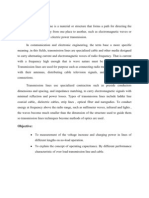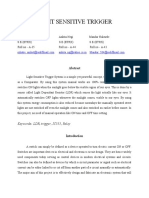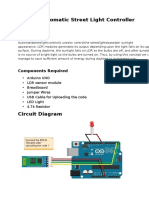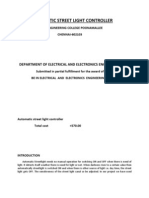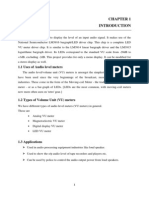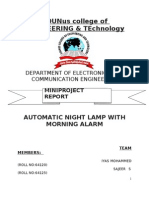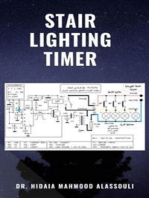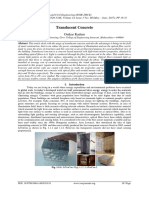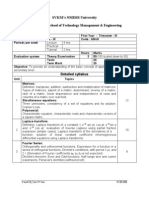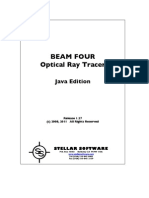Automatic Light Intensity Controller Using LDR and Relay
Automatic Light Intensity Controller Using LDR and Relay
Uploaded by
Jaswitha KonaCopyright:
Available Formats
Automatic Light Intensity Controller Using LDR and Relay
Automatic Light Intensity Controller Using LDR and Relay
Uploaded by
Jaswitha KonaOriginal Title
Copyright
Available Formats
Share this document
Did you find this document useful?
Is this content inappropriate?
Copyright:
Available Formats
Automatic Light Intensity Controller Using LDR and Relay
Automatic Light Intensity Controller Using LDR and Relay
Uploaded by
Jaswitha KonaCopyright:
Available Formats
Automatic light intensity controller using ldr and relay
CHAPTER 1
INTRODUCTION
Automatic Street Light Control System is a simple and powerful concept, which
uses transistor as a switch to switch ON and OFF the street light automatically. By
using this system manual works are removed. It automatically switches ON lights
when the sunlight goes below the visible region of our eyes. It automatically
switches OFF lights under illumination by sunlight. This is done by a sensor called
Light Dependant Resistor (LDR) which senses the light actually like our eyes By
using this system energy consumption is also reduced because now-a-days the
manually operated street lights are not switched off properly even the sunlight
comes and also not switched on earlier before sunset.
In sunny and rainy days, ON time and OFF time differ significantly which is one of
the major disadvantage of using timer circuits or manual . A street light, lamppost,
street lamp, light standard, or lamp standard is a raised source of light on the edge
of a road or walkway, which is turned on or lit at a certain time every night.
Modern lamps may also have light-sensitive photocells to turn them on at dusk, off
at dawn, or activate automatically in dark weather The system itself detects
whether there is need for light or not. When darkness rises to a certain value
Dept. of ECE Page 1
Automatic light intensity controller using ldr and relay
1.1Proposed method for automatic light intensity controller using
relay and ldr :
There are several ways to turn on the street lights but the following circuit
describes an Automatic Street Light Controller Circuit that uses LDR and Relay to
perform this job automatically.The circuit employed here is an uncomplicated
light/dark activated switch and contains a relay at its output, which simply turns
ON/OFF a street light and further can be extended to control any electrical
appliance in a household.
This circuit is very easy to work around and also it is battery operated. The power
consumed by the circuit is very low because of the very few components used in
the circuit. The whole circuit is based on IC LM358, which is basically an
operational amplifier that is configured in a voltage comparator. LDR (Light
depending resistor), whose resistance is based upon the quantity of the light falling
Dept. of ECE Page 2
Automatic light intensity controller using ldr and relay
on it, is the main component for sensing the light. Along with these, a few more
components are also used.
CHAPTER 2
2.1 Components Used:
● IC LM358 – 1
● Resistor 10KΩ – 1
● Potentiometer 10KΩ – 1
● 5V Relay Module – 1
● Small LED Strip
● 9V Battery
● LDR – 1
● Connecting Wires
● Breadboard
2.2 Components Description:
LM358 IC:
The LM358 IC is a great, low power and easy to use dual channel op-amp IC. It is
designed and introduced by national semiconductor. It consists of two internally
frequency compensated, high gain, independent op-amps. This IC is designed for
specially to operate from a single power supply over a wide range of voltages. The
LM358 IC is available in a chip sized package and applications of this op amp
Dept. of ECE Page 3
Automatic light intensity controller using ldr and relay
include conventional op-amp circuits, DC gain blocks and transducer amplifiers.
LM358 IC is a good, standard o perational amplifier and it is suitable for your
needs. It can handle 3-32V DC supply & source up to 20mA per channel. This
op-amp is apt, if you want to operate two separate op-amps for a single power
supply. It’s available in an 8-pin DIP package.
The pin diagram of LM358 IC comprises of 8 pins, where
Pin-1 and pin-8 are o/p of the comparator
Pin-2 and pin-6 are inverting i/ps
Pin-3 and pin-5 are non inverting i/ps
Pin-4 is GND terminal
Pin-8 is VCC+
● The features of the LM358 IC are
It consists of two op-amps internally and frequency compensated for
unity gain
The large voltage gain is 100 dB
Wide bandwidth is 1MHz
Range of wide power supplies includes single and dual power supplies
Range of Single power supply is from 3V to 32V
Range of dual power supplies is from + or -1.5V to + or -16V
The supply current drain is very low, i.e., 500 μA
2mV low i/p offset voltage
Common mode i/p voltage range comprises ground
The power supply voltage and differential i/p voltages are similar
Dept. of ECE Page 4
Automatic light intensity controller using ldr and relay
o/p voltage swing is large.
2.2 fig.1 LM IC 35
Resistor(10k):
A resistor is a passive two terminal electrical component that implements electrical
resistance as a circuit element. In electronic circuits, resistors are used to reduce
current flow, adjust signal levels, to divide voltages, bias active elements, and
terminate transmission lines, among other uses. High-power resistors that can
dissipate many watts of electrical power as heat, may be used as part of motor
controls, in power distribution systems, or as test loads for generators. Fixed
resistors have resistances that only change slightly with temperature, time or
operating voltage. Variable resistors can be used to adjust circuit elements (such as
a volume control or a lamp dimmer), or as sensing devices for heat, light, humidity,
force, or chemical activity.
Resistors are common elements of electrical networks and electronic circuits and
are ubiquitous in electronic equipment. Practical resistors as discrete components
can be composed of various compounds and forms. Resistors are also implemented
within integrated circuits.
Dept. of ECE Page 5
Automatic light intensity controller using ldr and relay
The electrical function of a resistor is specified by its resistance: common
commercial resistors are manufactured over a range of more than nine orders of
magnitude. The nominal value of the resistance falls within the manufacturing
tolerance, indicated on the component.
2.2 fig.2 resistor 10k
Potentiometer 10k:
A potentiometer is a three-terminal resistor with a sliding or rotating contact that
forms an adjustable voltage divider.[1] If only two terminals are used, one end and
the wiper, it acts as a variable resistor or rheostat.The measuring instrument called
a potentiometer is essentially a voltage divider used for measuring electric
potential (voltage); the component is an implementation of the same principle,
hence its name.
Potentiometers are commonly used to control electrical devices such as volume
controls on audio equipment. Potentiometers operated by a mechanism can be used
as position transducers, for example, in a joystick. Potentiometers are rarely used
to directly control significant power (more than a watt), since the power dissipated
in the potentiometer would be comparable to the power in the controlled load.
Dept. of ECE Page 6
Automatic light intensity controller using ldr and relay
2.2 fig.3 potentiometer 10k
5v Relay Module:
The isolation relay module is an electrically operated switch that allows you to turn
on or off a circuit using voltage and/or current much higher than a microcontroller
could handle. There is no connection between the low voltage circuit operated by
the microcontroller and the high power circuit. The relay protects each circuit from
each other. The module has three connections named NC, COM, and NO.
Depending on the input signal trigger mode, the jumper cap can be placed at high
level effective mode which ‘closes’ the normally open (NO) switch at high level
input and at low level effective mode which operates the same but at low level
input.
Specifications:
Onboard EL817 photoelectric coupler with photoelectric isolating
antiinterference ability strong.
Onboard 5 v, 10 A / 250 VAC, 10 A / 30 VDC relays, relay long life can
absorb 100000 times in a row.
Dept. of ECE Page 7
Automatic light intensity controller using ldr and relay
Module can be directly and MCU I/O link, input signal trigger mode (high
level effective mode and low level effective mode) can be choose by jumper
cap.
Module with the instructions and signal output diode current protection.
PCB size: 46 (mm) x17.6 (mm).
The 5v relay has three high voltage terminals (NC, C, and NO) which
connect to the device you want to control. The other side has three low
voltage pins (Ground, Vcc, and Signal) which connect to the arduino.
Pin terminals:
NC: Normally closed 120-240V terminal
NO: Normally open 120-240V terminal
C: Common terminal
Ground: Connects to the ground pin on the Arduino
5V Vcc: Connects the Arduino’s 5V pin
Signal: Carries the trigger signal from the Arduino that activates the
relay.
2.2 fig.4 5v relay module
Dept. of ECE Page 8
Automatic light intensity controller using ldr and relay
Inside the relay is a 120-240V switch that’s connected to an electromagnet. When
the relay receives a HIGH signal at the signal pin, the electromagnet becomes
charged and moves the contacts of the switch open or closed.
Small led strip:
A light-emitting diode (LED) is a semiconductor light source that emits light
when current flows through it. Electrons in the semiconductor recombine
with electron holes, releasing energy in the form of photons. This effect is
called electroluminescence. The color of the light (corresponding to the energy of
the photons) is determined by the energy required for electrons to cross the band
gap of the semiconductor. White light is obtained by using multiple
semiconductors or a layer of light-emitting phosphor on the semiconductor device.
LEDs have many advantages over incandescent light sources, including lower
energy consumption, longer lifetime, improved physical robustness, smaller size,
and faster switching. Light-emitting diodes are used in applications as diverse
as aviation lighting, automotive headlamps, advertising, general lighting, traffic
signals, camera flashes, lighted wallpaper and medical devices.Unlike a laser, the
color of light emitted from an LED is neither coherent nor monochromatic, but the
spectrum is narrow with respect to human vision, and functionally monochromatic.
2.2 fig.5 small led strip
Dept. of ECE Page 9
Automatic light intensity controller using ldr and relay
9v Battery:
The nine-volt battery, or 9-volt battery, is a common size of battery that was
introduced for the early transistor radios. It has a rectangular prism shape with
rounded edges and a polarized snap connector at the top. This type is commonly
used in walkie-talkies, clocks and smoke detectors.
The nine-volt battery format is commonly available in primary carbon-zinc and
alkaline chemistry, in primary lithium iron disulfide, and in rechargeable form in
nickel-cadmium, nickel-metal hydride and lithium-ion. Mercury-oxide batteries of
this format, once common, have not been manufactured in many years due to their
mercury content. .Most nine-volt alkaline batteries are constructed of six individual
1.5 V LR61 cells enclosed in a wrapper. These cells are slightly smaller than
LR8D425 AAAA cells and can be used in their place for some devices, even
though they are 3.5 mm shorter. Carbon-zinc types are made with six flat cells in a
stack, enclosed in a moisture-resistant wrapper to prevent drying. Primary lithium
types are made with three cells in series.
In 2007, 9-volt batteries accounted for 4% of alkaline primary battery sales in the
United States. In Switzerland in 2008, 9-volt batteries total 2% of primary battery
sales and 2% of secondary battery sales.
Dept. of ECE Page 10
Automatic light intensity controller using ldr and relay
2.2 fig.6 9v battery
LDR:
A photoresistor or light dependent resistor is a component that is sensitive to light.
When light falls upon it then the resistance changes. Values of the resistance of the
LDR may change over many orders of magnitude the value of the resistance falling
as the level of light increases. LDRs are made from semiconductor materials to
enable them to have their light sensitive properties.
Many materials can be used, but one popular material for these photoresistors is
cadmium sulphide, CdS. It is relatively easy to understand the basics of how an
LDR works without delving into complicated explanations. It is first necessary to
understand that an electrical current consists of the movement of electrons within a
material. Good conductors have a large number of free electrons that can drift in a
given direction under the action of a potential difference. Insulators with a high
resistance have very few free electrons, and therefore it is hard to make the them
move and hence a current to flow.
An LDR or photoresistor is made any semiconductor material with a high
resistance. It has a high resistance because there are very few electrons that are free
Dept. of ECE Page 11
Automatic light intensity controller using ldr and relay
and able to move - the vast majority of the electrons are locked into the crystal
lattice and unable to move. Therefore in this state there is a high LDR resistance.
2.2 fig.7 LDR
Dept. of ECE Page 12
Automatic light intensity controller using ldr and relay
CHAPTER 3
3.1 circuit Diagram:
3.1.1 circuit diagram of automatic light intensity controller using ldr and 5v relay module
3.2 working principle:
The working of circuit is very much easy to understand. In this circuit, we used IC
LM358,which is basically an operational amplifier. Pins 2 and 3 of these IC are
used to compare thevoltage and give us an output as high or low depending on the
voltages at the input pins.
In this circuit, LDR and 10KΩ Resistor form one potential divider pair, which is
used toprovide a variable voltage at the non-inverting input (that is Pin 3). The
second potentialdivider is built around inverting input (Pin 2) with the help of
10KΩ Potentiometer, whichwill supply half of the supply voltage to inverting pin.
Dept. of ECE Page 13
Automatic light intensity controller using ldr and relay
3.2.1 At day time,led does not glow due to low resistance of ldr
As we know the property of LDR that during the day time, its resistance is
low, the voltage atthe non-inverting input (i.e. pin 3) is higher than the voltage at
the inverting input (pin 2).Hence, the output at the pin 1 is high. As a result, the
relay is OFF and the LED (or the bulb)will not glow.
3.2.2 At night time,led glow due to high resistance of ldr
But in dimness or at night time, we know that resistance of LDR is high. Hence,
the voltageat non-inverting input pin 3 of the IC LM358 decreases than the
inverting input pin 2. As aresult, the output pin 1 moves to low state, which further
makes the relay to activate and theLED or bulb associated to it will glow
Dept. of ECE Page 14
Automatic light intensity controller using ldr and relay
CHAPTER 4
Simulation results:
Dept. of ECE Page 15
Automatic light intensity controller using ldr and relay
CHAPTER 5
Advantages and Disadvantages:
By using this automatic system for street light controlling ,we can reduce energy
consumption because the manually operated street lights are not switch off
properly even the sun light comes and Also not switched on earlier before sunset
• Low cost
• Automated operation
• Low power consumption
• Very flexible
• Easy to manufactured In sunny and rainy days, on and off time differ notice
which is one of the major disadvantages of using timer circuit or manual operation
for switching the street light system.
Applications:
1. Used in street light applications.
2. Used in Domestic applications.
Dept. of ECE Page 16
You might also like
- PROJECT RIPORT ChapterDocument16 pagesPROJECT RIPORT Chapterdarkfire28304No ratings yet
- Service Manual: Conditions of UseDocument70 pagesService Manual: Conditions of Usejoan beNo ratings yet
- Automatic Street Light Control Using LDRDocument20 pagesAutomatic Street Light Control Using LDRAshok64% (11)
- Tarns Mission Line Performance (No Load)Document6 pagesTarns Mission Line Performance (No Load)Mohamed Faisal75% (4)
- Plasmonics:From Basics To Advanced TopicsDocument330 pagesPlasmonics:From Basics To Advanced TopicsOzan ErturkNo ratings yet
- Project Jasi 2 Final PDFDocument30 pagesProject Jasi 2 Final PDFJaswitha KonaNo ratings yet
- Adaptive Lighting System For Automobiles: A Project Report OnDocument13 pagesAdaptive Lighting System For Automobiles: A Project Report Onashishgusain1991No ratings yet
- Automatic Street Light Controller Circuit Using Relays and LDRDocument4 pagesAutomatic Street Light Controller Circuit Using Relays and LDRRavindra ParabNo ratings yet
- Electrical & Electronics Department 2009-2010Document20 pagesElectrical & Electronics Department 2009-2010nirveshdagarNo ratings yet
- Street Light ControlDocument3 pagesStreet Light Controlvijesh_annaNo ratings yet
- Automatic Street Light Control System (Final Project Report)Document7 pagesAutomatic Street Light Control System (Final Project Report)Filza FatimaNo ratings yet
- Experiment #04: Introduction To Relay and Its Application (Controlling of 220v Using 5v Relay)Document8 pagesExperiment #04: Introduction To Relay and Its Application (Controlling of 220v Using 5v Relay)Ayaz FaisalNo ratings yet
- Power FactorDocument25 pagesPower FactorSri Sai ComputersNo ratings yet
- Mini Project Report 2010-11 GPTC MeppadiDocument18 pagesMini Project Report 2010-11 GPTC MeppadiAkhil V MohanNo ratings yet
- Adaptive Lighting System For AutomobilesDocument29 pagesAdaptive Lighting System For Automobilesspruhatech100% (1)
- Remote Override of Traffic Signal in Emergency: Under The Guidance ofDocument23 pagesRemote Override of Traffic Signal in Emergency: Under The Guidance ofDebashishParidaNo ratings yet
- Mini Project On Dark Sensor Using IC555 TimerDocument16 pagesMini Project On Dark Sensor Using IC555 TimerPSNo ratings yet
- Project Report 1Document7 pagesProject Report 1Fawad Shakil AsgharNo ratings yet
- Automatic Lighting SystemDocument10 pagesAutomatic Lighting Systempanjala ruthvikNo ratings yet
- Qa 00177 Automatic Street Light ControlDocument10 pagesQa 00177 Automatic Street Light Controlashley_rodrigues_20No ratings yet
- Li-Fi Industries Communication Using Laser Media in Open SpaceDocument61 pagesLi-Fi Industries Communication Using Laser Media in Open SpaceVinothKumar100% (1)
- Automatic Traffic Light Control SystemDocument4 pagesAutomatic Traffic Light Control SystemRajaMandapatiNo ratings yet
- Smart Street Light System PDFDocument22 pagesSmart Street Light System PDFDevesh SrivastavaNo ratings yet
- LED Lamp Dimmer CircuitDocument3 pagesLED Lamp Dimmer CircuitashishNo ratings yet
- Atm Security PsyDocument84 pagesAtm Security Psyarunraja98No ratings yet
- Light Sensitive TriggerDocument9 pagesLight Sensitive Triggerhoney_janu50% (2)
- ReportDocument14 pagesReportAkash SiboNo ratings yet
- EEE ProjectDocument4 pagesEEE Projectpa7pkjNo ratings yet
- Introduction Home Automation Circuit Diagram Components Required Components Description Circuit Description Applications ConclusionDocument26 pagesIntroduction Home Automation Circuit Diagram Components Required Components Description Circuit Description Applications ConclusionPratiksha SharmaNo ratings yet
- Automatic Street Light ControllerDocument4 pagesAutomatic Street Light ControllerMaha BuNo ratings yet
- Automatic Railway Gate Controller Project ReportDocument32 pagesAutomatic Railway Gate Controller Project ReportAbhijeet Pareek71% (7)
- Audio Level MeterDocument27 pagesAudio Level MeterkrishnayahooNo ratings yet
- Eye BlinkDocument31 pagesEye BlinkPoorva Gupta67% (3)
- Electricity RelayDocument21 pagesElectricity RelaypraneethNo ratings yet
- RF Controlled ApplianceDocument14 pagesRF Controlled ApplianceNEX456No ratings yet
- Aa (0000)Document9 pagesAa (0000)Prajwol TimalsinaNo ratings yet
- AC Dimmer: Components RequiredDocument8 pagesAC Dimmer: Components Requiredovais123No ratings yet
- Regulated Power SupplyDocument19 pagesRegulated Power Supplyimran kadriNo ratings yet
- LIC - Unit V NotesDocument13 pagesLIC - Unit V NotesJagan GcNo ratings yet
- Automatic Doc XDocument21 pagesAutomatic Doc Xakash mishraNo ratings yet
- 11.chapter 3Document16 pages11.chapter 3hsushweyi tint28No ratings yet
- Electronics ComponentsDocument7 pagesElectronics ComponentsAnand DahikarNo ratings yet
- Driving Relays With stm32f407vgtx Microcontroller Using Uln2003 Relay DriverDocument12 pagesDriving Relays With stm32f407vgtx Microcontroller Using Uln2003 Relay DriverAnonymous Nlaa5HNo ratings yet
- Younus College of Engineering & TechnologyDocument8 pagesYounus College of Engineering & TechnologySarath Mohan JNo ratings yet
- SjhaDocument40 pagesSjhamohit meshramNo ratings yet
- 1.2 Block Diagram With Explanation:: Chapter-1Document27 pages1.2 Block Diagram With Explanation:: Chapter-1Vamshi KrishnaNo ratings yet
- Kit InstructionsDocument10 pagesKit InstructionsRM EletronicaNo ratings yet
- Final Report Activate SwitchDocument65 pagesFinal Report Activate SwitchThufail AhmedNo ratings yet
- Full Report ET2Document15 pagesFull Report ET2NurulSyafiqahNo ratings yet
- SynopsisDocument12 pagesSynopsisGhazalpreet KaurNo ratings yet
- N568PPTDocument29 pagesN568PPTRavi PexelsNo ratings yet
- Automatic Night Lamp With Morning AlarmDocument4 pagesAutomatic Night Lamp With Morning AlarmijaertNo ratings yet
- Introduction To Relay: Presented by STES Group LTDDocument18 pagesIntroduction To Relay: Presented by STES Group LTDMugisha EdwinNo ratings yet
- Block Diagram For Simple Traffic Light SystemDocument17 pagesBlock Diagram For Simple Traffic Light SystemVishwaraj Bhagwat88% (16)
- Chapter-1Document37 pagesChapter-1anuj kumarNo ratings yet
- Earth Fault Relay in A Single Phase Power System.Document31 pagesEarth Fault Relay in A Single Phase Power System.Soumya Bhattacharya100% (2)
- Welcome To The Presentation: The Name of Our Project IsDocument24 pagesWelcome To The Presentation: The Name of Our Project IsDebalina PandaNo ratings yet
- OptocopularDocument10 pagesOptocopularramu rupikaNo ratings yet
- Reference Guide To Useful Electronic Circuits And Circuit Design Techniques - Part 1From EverandReference Guide To Useful Electronic Circuits And Circuit Design Techniques - Part 1Rating: 2.5 out of 5 stars2.5/5 (3)
- Reference Guide To Useful Electronic Circuits And Circuit Design Techniques - Part 2From EverandReference Guide To Useful Electronic Circuits And Circuit Design Techniques - Part 2No ratings yet
- Analog Dialogue Volume 46, Number 1: Analog Dialogue, #5From EverandAnalog Dialogue Volume 46, Number 1: Analog Dialogue, #5Rating: 5 out of 5 stars5/5 (1)
- MG GaussianBeamsDocument18 pagesMG GaussianBeamsPamela Aimée SanchezNo ratings yet
- Translucent Concrete: Omkar KadamDocument14 pagesTranslucent Concrete: Omkar KadamJakka hitheshiniNo ratings yet
- Capacitive Level MeasurementDocument6 pagesCapacitive Level MeasurementtadagidsNo ratings yet
- Btech Trimester 3 SyllabusDocument12 pagesBtech Trimester 3 SyllabusAditya MehtaNo ratings yet
- TIJER2212009Document6 pagesTIJER2212009Vishwa ChethanNo ratings yet
- Underwater Laser Welding by 4kW CW YAG LaserDocument5 pagesUnderwater Laser Welding by 4kW CW YAG LaserKhalid M. HafezNo ratings yet
- Photodiode THERMISTOR UM66Document16 pagesPhotodiode THERMISTOR UM66Shashank KesasrwaniNo ratings yet
- Mini Spectrometer Kacc9003eDocument34 pagesMini Spectrometer Kacc9003eAnonymous Kti5jq5EJINo ratings yet
- 1550nm Erbium-Ytterbium-Doped Fiber Amplifier: FeaturesDocument3 pages1550nm Erbium-Ytterbium-Doped Fiber Amplifier: FeaturesJaime Orlando Caicedo DiazNo ratings yet
- BPW43Document5 pagesBPW43pome14No ratings yet
- Flame QuenchingDocument10 pagesFlame QuenchingSufian KhalidNo ratings yet
- 26 Gbit-S LiFi System With Laser-Based White Light TransmitterDocument8 pages26 Gbit-S LiFi System With Laser-Based White Light Transmitterdipakkushwaha525No ratings yet
- Research Article: Vibration and Modal Analysis of Low Earth Orbit SatelliteDocument9 pagesResearch Article: Vibration and Modal Analysis of Low Earth Orbit SatelliteAmritansh RanjanNo ratings yet
- B4guide 127Document137 pagesB4guide 127AeronomerNo ratings yet
- IC Fabrication Process: Course: VLSI DesignDocument14 pagesIC Fabrication Process: Course: VLSI DesignDwayne WaltonNo ratings yet
- Multi-Gigabit S LiFi Networking For 6GDocument2 pagesMulti-Gigabit S LiFi Networking For 6Gcharan cherryNo ratings yet
- 5 X 7 Matrix Display: LM-2035 SeriesDocument4 pages5 X 7 Matrix Display: LM-2035 SeriesJUANnn100No ratings yet
- Fluorescent Polymeric Nanoparticles Fabricated by Plasma Polymerization Under Atmospheric Pressure and Room TemperatureDocument5 pagesFluorescent Polymeric Nanoparticles Fabricated by Plasma Polymerization Under Atmospheric Pressure and Room TemperatureRoberto VeraNo ratings yet
- Anritsu Understanding OtdrsDocument60 pagesAnritsu Understanding OtdrsMathieu Bolle100% (3)
- DXR Raman Ficha TecnicaDocument4 pagesDXR Raman Ficha TecnicaFernando Torres PérezNo ratings yet
- Examination of Surface Residuals Obtained During Re-Lubrication of The International Space Station (ISS) Solar Alpha Rotary Joint (SARJ)Document32 pagesExamination of Surface Residuals Obtained During Re-Lubrication of The International Space Station (ISS) Solar Alpha Rotary Joint (SARJ)anhntran4850No ratings yet
- Gamma Ray DetectorsDocument22 pagesGamma Ray Detectorsionik_marva6181No ratings yet
- Advancements PVD CoatingsDocument14 pagesAdvancements PVD CoatingszeNo ratings yet
- Exercise 3: Microscopy Techniques: BE132P Instrumentation in Biological Engineering 1Document3 pagesExercise 3: Microscopy Techniques: BE132P Instrumentation in Biological Engineering 1Bernadette Virola CuevasNo ratings yet
- SKIF : Portable Anti-Tank Missile Complex With PN-S Guidance DeviceDocument18 pagesSKIF : Portable Anti-Tank Missile Complex With PN-S Guidance DevicePetro PyatakovNo ratings yet
- Samsung scx-340x Series Service Manual PDFDocument130 pagesSamsung scx-340x Series Service Manual PDFGC ToolbarNo ratings yet



